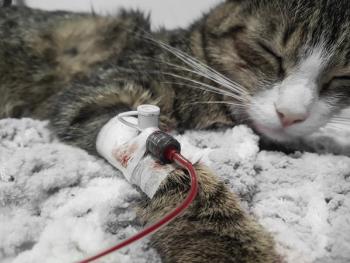
Wearable Flash Glucose Monitor Tested in Dogs
A flash glucose monitor worn on the skin was well tolerated by dogs with diabetes mellitus, according to a study recently published in the Journal of Veterinary Internal Medicine.
A flash glucose monitor worn on the skin was well tolerated by dogs with diabetes mellitus, according to a study recently published in the
The device used in the study (FreeStyle Libre, Abbott Laboratories) is a continuous glucose monitoring system that does not require finger pricks and can remain in place for 14 days. The device uses a skin-mounted sensor attached to a small filament that measures interstitial glucose in the subcutaneous tissue. Patients receive results by scanning the sensor with a handheld reader. The device measures interstitial glucose every minute beginning 1 hour after application and can detect glucose concentrations between 20 and 500 mg/dL. It has been licensed for use in Europe since 2014 but is not currently available in the United States.
In this study, investigators from the University of Bologna, Italy, tested the accuracy of the flash glucose monitor in 10 client-owned dogs with diabetes mellitus. Each dog had been treated with insulin for at least 1 month. Investigators clipped and cleaned a patch of skin on each dog’s neck, placed a sensor using the applicator provided by the manufacturer, secured the sensor with extra tape and bandaging, and left it in place for 14 days.
The authors collected several glucose readings from the flash glucometers during three 36-hour time periods: days 1 to 2, 6 to 7, and 13 to 14. During each of these periods, they also collected venous blood samples every 2 to 3 hours and measured plasma glucose with a blood chemistry analyzer using the hexokinase method as the reference standard.
All dogs tolerated the sensors and bandages well. In 3 dogs, the devices stopped taking readings after the sensors became detached from the skin. When the sensors were removed at the end of the study, half of the dogs had mild erythema at the application site. In 1 dog, the needle was found to be bent.
Compared with the reference standard, the clinical accuracy of the flash glucometer was 93% for measurements in the hypoglycemic range (<70 mg/dL) and 99% for those in the euglycemic (70-180 mg/dL) and hyperglycemic (>180 mg/dL) ranges. The overall mean difference between interstitial glucose measured by the flash glucometer and plasma glucose measured by the hexokinase method was 2.3 mg/dL (standard deviation, 46.8 mg/dL).
Skin thickness and inflammation could affect the results of the readings, write the authors. Study limitations included the small sample size and the lack of glucometer precision testing (only 1 sensor was used in each dog). The authors note that the flash glucometer did not seem able to detect rapid changes between peripheral blood glucose and interstitial glucose. They recommend further studies to evaluate the device’s long-term use in dogs and its ability to detect hypoglycemia.
Dr. Laurie Anne Walden received her doctorate in veterinary medicine from North Carolina State University. After an internship in small animal medicine and surgery at Auburn University, she returned to North Carolina, where she has been in small animal primary care practice for over 20 years. Dr. Walden is also a board-certified editor in the life sciences and owner of Walden Medical Writing, LLC.
Newsletter
From exam room tips to practice management insights, get trusted veterinary news delivered straight to your inbox—subscribe to dvm360.




